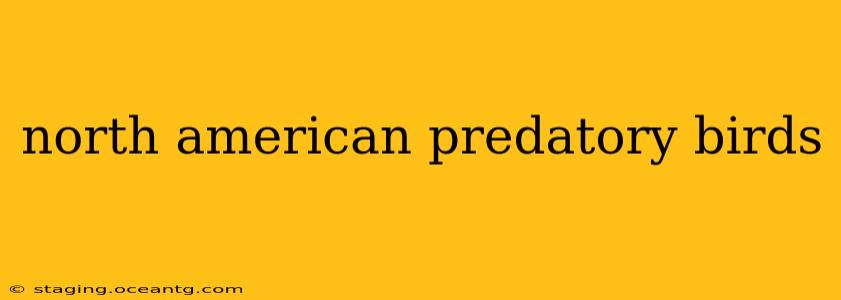North America boasts a diverse array of predatory birds, each uniquely adapted to its environment and prey. From the majestic bald eagle to the stealthy peregrine falcon, these raptors play a crucial role in maintaining the delicate balance of their ecosystems. This guide explores the fascinating world of North American predatory birds, covering various species, their habitats, hunting techniques, and conservation status.
What are the different types of predatory birds in North America?
North America is home to a wide variety of predatory birds, belonging to several families. These include:
-
Accipitridae (Hawks, Eagles, Kites, and Old World Vultures): This family includes a vast array of species, from the ubiquitous Red-tailed Hawk to the majestic Bald Eagle. They vary significantly in size, appearance, and hunting strategies. For example, the Red-tailed Hawk is a generalist predator, while the Bald Eagle specializes in fish and carrion.
-
Falconidae (Falcons): Known for their incredible speed and agility, falcons are specialized aerial hunters. The Peregrine Falcon, the fastest animal on Earth, is a prime example, capable of reaching speeds exceeding 200 mph during its stoop (high-speed dive). Other notable North American falcons include the American Kestrel and the Merlin.
-
Strigidae (Owls): These nocturnal hunters are masters of stealth and possess exceptional hearing and night vision. The Great Horned Owl, a powerful predator, is capable of taking down prey much larger than itself. Smaller owls, such as the Eastern Screech Owl, typically hunt smaller rodents and insects.
-
Cathartidae (New World Vultures): While not strictly predators in the sense that they don't actively hunt, New World Vultures play a vital role in the ecosystem by scavenging carrion. This helps prevent the spread of disease and keeps the environment clean. The Black Vulture and Turkey Vulture are common examples found throughout North America.
What are some common predatory birds found in North America?
Several predatory bird species are widespread and easily recognized throughout North America. These include:
-
Bald Eagle ( Haliaeetus leucocephalus): A national symbol of the United States, the Bald Eagle is a large, powerful bird of prey known for its distinctive white head and tail.
-
Red-tailed Hawk (Buteo jamaicensis): One of the most common hawks in North America, the Red-tailed Hawk is easily identified by its reddish-brown tail.
-
Peregrine Falcon (Falco peregrinus): The fastest animal on Earth, the Peregrine Falcon is a powerful aerial hunter found across a variety of habitats.
-
Great Horned Owl (Bubo virginianus): A large, powerful owl with distinctive ear tufts, the Great Horned Owl is a widespread predator found throughout North America.
How do predatory birds hunt?
Predatory birds employ a variety of hunting techniques, depending on their species and prey. Some common strategies include:
-
Stooping: Falcons are masters of this technique, diving at high speeds to capture their prey.
-
Perching and ambushing: Hawks and owls often perch in strategic locations, waiting for unsuspecting prey to come within striking distance.
-
Aerial pursuit: Some species, like the Peregrine Falcon, pursue their prey in flight.
-
Scavenging: Vultures primarily feed on carrion, playing a crucial role in the ecosystem's sanitation.
What is the conservation status of North American predatory birds?
The conservation status of North American predatory birds varies widely depending on the species. Some species, like the Bald Eagle, have made remarkable recoveries from near extinction thanks to conservation efforts. Others still face threats from habitat loss, pesticide use, and human-wildlife conflict. It's crucial to continue monitoring and protecting these magnificent birds and their habitats.
Are predatory birds dangerous to humans?
While predatory birds are powerful hunters, attacks on humans are extremely rare. Most species will avoid contact with humans unless they feel threatened or are protecting their nests. However, it's always important to maintain a safe distance and observe these birds from a respectful distance.
What is the role of predatory birds in the ecosystem?
Predatory birds play a vital role in maintaining the balance of their ecosystems. By controlling populations of rodents, rabbits, and other small animals, they help prevent overgrazing and the spread of disease. They are an essential part of a healthy and functioning ecosystem.
How can I help conserve predatory birds?
You can contribute to the conservation of North American predatory birds by supporting organizations dedicated to their protection, advocating for responsible land management practices, and reducing your impact on the environment. Simple actions like avoiding the use of pesticides and reducing light pollution can make a significant difference.
This guide provides a starting point for understanding the fascinating world of North American predatory birds. Further research into specific species and their habitats will reveal even more about these magnificent creatures and their crucial role in our ecosystems.
